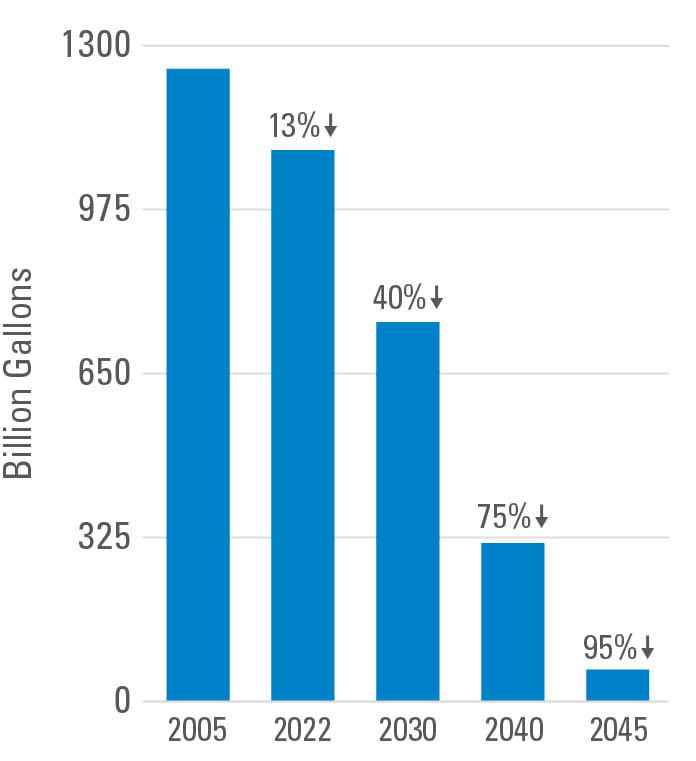Air, Water and Climate Change
Ameren has set ambitious goals to guide us on our path to a sustainable energy future. We strive to achieve net-zero carbon emissions by 2045 and are targeting a 95% reduction of water withdrawn for thermal generation by 2045. Our goal is to reduce carbon emissions 60% by 2030 and 85% by 2040, from 2005 levels. The new goals accelerate and expand on our 2020 pledge and are consistent with the objectives of the Paris Agreement in limiting global temperature rise to 1.5 degrees Celsius.Ameren's Climate Change Strategy
Climate change risks are included in Ameren’s risk management processes to allow our business to make prudent decisions while meeting our customers’ energy needs in a safe, reliable, affordable and environmentally responsible manner.
Our strategy for effectively addressing key climate change risks while positioning Ameren to continue to deliver long-term value to our customers, communities and shareholders is largely embedded in Ameren Missouri’s Integrated Resource Plan (IRP).
The IRP outlines Ameren Missouri’s approach for the next several decades. This plan will require an investment of billions of dollars and create thousands of jobs, all without compromising reliability and affordability for our customers.
Our largest-ever expansion into wind and solar generation
Continued generation through other clean energy sources, including hydro and nuclear generation
Accelerated retirement of our coal-fired energy centers
Continued energy efficiency programs for Missouri and Illinois electric customers
Integrated Resource Plan
Read more about Ameren Missouri’s strategy to address global climate change.
 Air Quality Management
Air Quality Management
Our primary sources of air emissions are Ameren Missouri’s fossil-fueled energy centers. Smaller amounts of emissions can also be attributed to our natural gas and electric delivery operations. To mitigate this, we have invested in a robust infrastructure at our facilities, air scrubbers, burning low-sulfur coal and optimizing other emissions control equipment at our coal-fired energy centers.
We monitor air quality via equipment installed at our facilities. Air monitors set up near several of our facilities provide additional reassurance to customers and others. Thanks to the measures we have taken at our operations, our air emissions are well below state and federal limits.
Air Quality Reports
Ameren provides air quality reports to keep our stakeholders informed about our operations.
- Missouri Department of Natural Resources: Hourly SO2 readings from ambient air monitors operated by the state of Missouri. Download report.
- Public Health Consequences of Air Emissions in the St. Louis Area: A case study assessment of air quality and public health claims related to stack emissions from Ameren Missouri's fossil fuel energy centers. Download report.
- Health Effects of SO2: A toxicologist's perspective on the health effects of sulfur dioxide. Download report.
Water Management
We are committed to protecting and minimizing our impact on natural resources by reducing our water use and returning clean water to our environment. We are targeting a 95% reduction of water withdrawn for thermal generation by 2045, according to a 2005 baseline. We have made progress toward our target by already reducing withdrawal by 140 billion gallons annually since 2005.
Operations at our facilities comply with regulatory standards established by the federal Clean Water Act and state-issued permits. In addition, our water management approach goes beyond those mandates and includes processes to protect freshwater and groundwater in the regions where we operate as well as reducing consumption where possible.
We received an B on our 2023 CDP Water Security Questionnaire. The CDP details our use of water resources and management strategy for the water resources we use. Our latest response to the CDP, as well as other reports related to water management, can be found here.
We regularly evaluate water-related issues as part of our overall business strategy and long-term financial planning. In 2018, we conducted a Water Resiliency Assessment that assessed the current and future availability of water resources and potential water stress in our regions of operation and key portions of our supply chain. This information is helping us better plan for our business’s future water needs.
How We Use Water
The majority of water we use is fresh surface water that comes from the Mississippi, Missouri, and Osage rivers. Most of this is used for clean hydroelectric power generation, which contributes to Ameren’s goal to achieve net-zero carbon emissions by 2045. Ameren Missouri operates three hydroelectric energy centers that harness freshwater and pumped water to create power. Water releases from these facilities are monitored and managed to meet regulatory criteria.
Freshwater is also used for non-contact thermal cooling at our nuclear and coal-fired energy centers. A small fraction of water is used for non-cooling purposes, which is treated in our wastewater treatment systems before it is discharged back to the river from where it came. All water is closely monitored in accordance with our specific permit limits and 99% of what is withdrawn from river systems is safely returned to the environment.
Water Reduction Targets for Thermal Generation*
*Targets based on retirement schedules presented in the 2023 Integrated Resource Plan Update. The updated plan advanced the 2030 reduction target from 30% to 40%.
Water Reduction Targets
We are targeting a 95% reduction in water withdrawal for thermal generation (i.e., all non-hydroelectric generation) by 2045, with interim targets of 40% by 2030, and 75% by 2040, compared to 2005 levels. Our water reduction targets coincide with the retirement of our coal-fired energy centers, as presented in Ameren Missouri's Integrated Resource Plan.
As of December 31, 2022, we reduced water withdrawal for thermal generation by 13% from 2005 levels. This reduction is due to the retirement of two coal-fired energy centers, and recent investments to convert to dry ash handling at our coal-fired energy centers.
Access Ameren Water Policy
